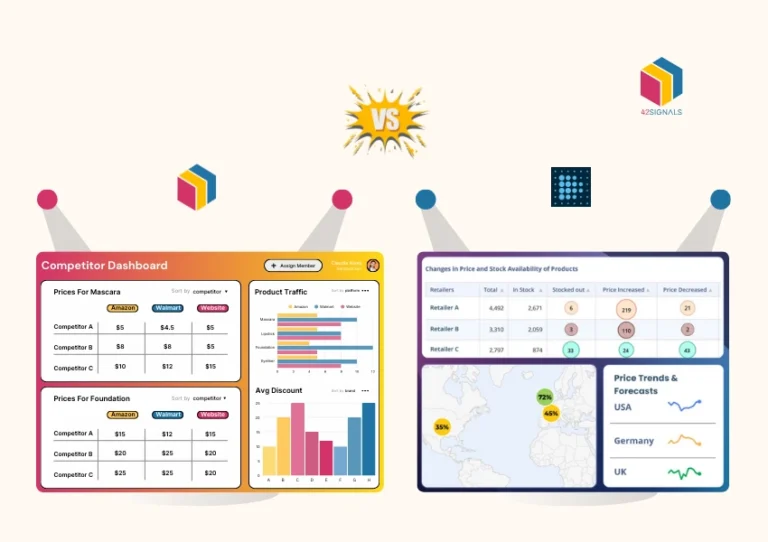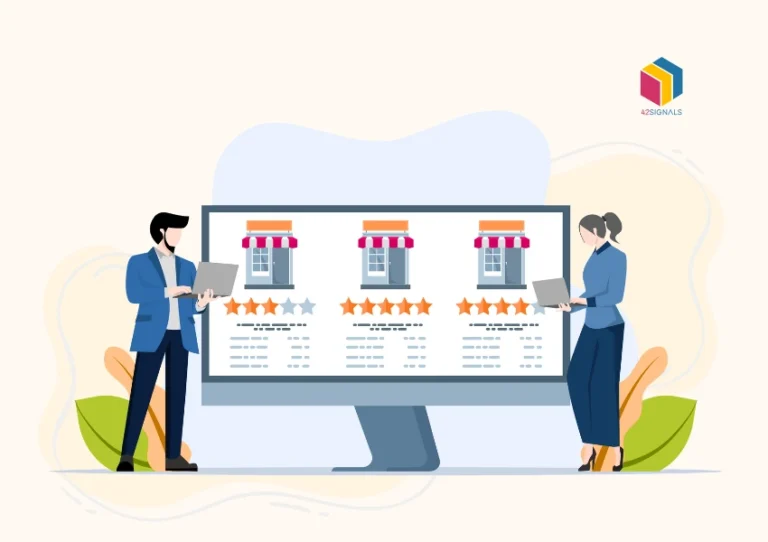Table of Contents
Toggle** TL;DR ** Forget just Google rankings – your organic share of voice (oSOV) on marketplaces like Amazon is now critical because that’s where most shoppers start (74% begin on Amazon!). Your oSOV is your natural visibility percentage in relevant searches there, directly driving traffic, sales, and lower costs, while acting as a key market share predictor and enabling vital competitor benchmarking. Boost it by mastering marketplace-specific keyword research (using share of search analytics and tools like 42Signals for Amazon keyword ranking), relentlessly optimizing listings with compelling content and visuals, actively managing reviews and ratings, ensuring competitive pricing and stock, and continuously tracking performance with digital shelf analytics – because maintaining strong oSOV requires constant monitoring and adjustment to stay visible where buyers actually shop.e pricing strategy playbook backed by real-time digital shelf analytics and tools like 42Signals.
For a long time, every business was obsessed with securing the top spot on Google. But recently, something big has shifted, especially if you’re selling actual stuff. The real battleground for eyeballs and wallets? It’s moved. More and more, people aren’t starting their hunt on a search engine. They’re typing “coffee maker” straight into Amazon or “new sneakers” into Walmart.com. That’s the new starting line. And that means your organic share of voice (oSOV) on these massive online stores is becoming just as critical as your old-school SEO ranking.
Let’s find out what it’s all about.
Breaking Down Organic Share of Voice: What it Means on Marketplaces
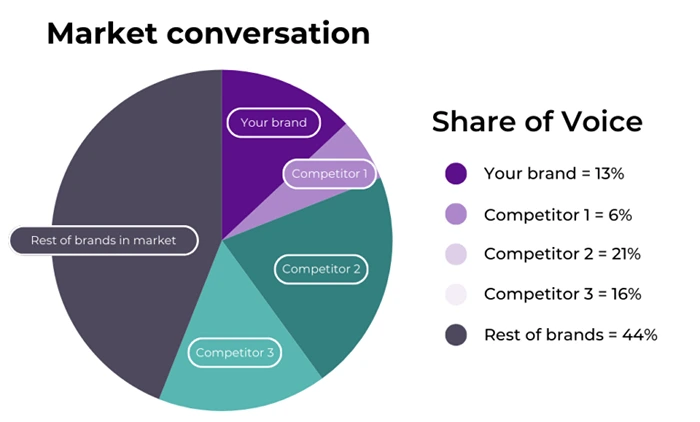
Image Source: Flip Flow
Imagine organic share of voice as your brand’s natural visibility score within a specific marketplace. When shoppers search for terms related to what you sell, how often do they actually see your products pop up on that crucial first page of results – without you paying for an ad spot?
Picture this: 100 people search “wireless noise-canceling headphones” on Amazon. If 40 of them naturally see your best-selling pair sitting pretty on page one (not as a sponsored ad), then your organic share of voice for that search is roughly 40%. It boils down to the visibility you’ve earned because the marketplace’s algorithm thinks your listing is genuinely relevant and useful for that shopper’s query.
This visibility lives and dies by your Amazon keyword ranking – where your product lands for specific searches is the engine powering your oSOV. If you’re not ranking well, you’re practically invisible.
Marketplace Organic Share of Voice: Forget Yesterday’s SEO, This is Where the Fight Is Now

Why has this become such a big deal? It boils down to a few fundamental shifts in how people shop:
The Search Starting Point Has Changed: Seriously, think about your own habits. Need batteries? A new phone charger? Odds are, you head straight to Amazon or a similar big box store online. You skip Google entirely. Share of search analytics back this up big time. For example, a pretty eye-opening 2023 report by Jungle Scout found that 74% of U.S. consumers kick off their product searches directly on Amazon. That’s a massive chunk of potential customers starting their journey where you might not even be tracking visibility! If you’re only watching Google, you’re missing most of the race.
It’s Where Buying Happens: Marketplaces aren’t just about browsing; they’re built for buying. High organic share of voice doesn’t just get you noticed; it puts your product right where the ‘Add to Cart’ button lives. Strong oSOV means you’re front and center when someone is actually ready to pull out their credit card. It’s prime real estate at the point of decision.
Algorithms Rule Here Too: Just like Google, marketplaces run on complex, ever-changing algorithms deciding what products show up and where. Optimizing your listings to please these algorithms – through smart keywords, compelling content, great images, positive reviews, and sharp pricing – is absolutely the new SEO. Ignoring your Amazon keyword ranking and overall marketplace presence today is like ignoring Google SEO a decade ago. You’ll fade into the background fast.
Why Bother? The Real-World Punch of a Strong Organic Share of Voice
Boosting your organic share of voice isn’t about chasing some abstract metric. It directly fuels your business engine:

Getting Seen (A Lot More): Higher oSOV or share of search simply means more shoppers see your products. More visibility naturally translates to more clicks landing on your product pages. It’s the most fundamental way to drive traffic within the marketplace itself.
Turning Browsers into Buyers: There’s something about organic placement. It naturally builds trust. When consumers find unsponsored listings, they make quicker decisions knowing that it’s real and isn’t an advertisement.
Saves Money: A healthy organic presence acts like free advertising. Those organic clicks cost you nothing per click, dramatically lowering your overall cost to acquire a customer.
Knowing Where You Stand: Competitor Benchmarking: Understanding your oSOV compared to your rivals is pure gold for competitor benchmarking. Are you gaining ground or losing it?
A Crystal Ball for Market Share? Often, your organic share of voice acts as a strong predictor of your actual sales market share on that platform. If you’re consistently invisible in search results, you’re probably not grabbing much sales volume either. Watching oSOV trends can give you early warnings or confirm you’re on the right track.
Building Your oSOV Fortress: It’s More Than Just Keywords
Optimizing for organic share of voice is a multi-layered job, much like traditional SEO. You need to get several things right:
Keyword Relevance & Smart Placement (The Bedrock)
It all starts with knowing what real people type into that marketplace search bar. Deep, marketplace-specific keyword research is non-negotiable. This directly feeds your Amazon keyword ranking potential. You need to weave these terms naturally into your product title, key features (bullet points), and description. But beware – jamming keywords in awkwardly hurts readability and gets penalized. Relevance and a smooth read win.

Product Content That Grabs & Holds (The Magnet)
Your title needs to be clear and keyword-rich. Your images and videos must be professional and compelling. Your bullet points should scream benefits, not just features. Your description needs to tell a story and answer questions. This content has one job: convince the shopper who found you through your organic share of voice to click and then buy. Bland descriptions kill conversions.
Reviews & Ratings (Your Street Cred)
This is HUGE for ranking. Products with more positive reviews and higher average ratings consistently snag better organic share of voice. Marketplaces trust products that shoppers trust. Proactively encouraging genuine reviews (ethically!) and thoughtfully managing feedback – especially negative comments – is absolutely critical. Silence or poor responses hurt.
Price & Stock (The Deal Makers or Breakers)
Rank high? Great! But if your price is way out of line or, worse, you’re out of stock, you lose the sale instantly. Worse, the algorithm notices that missed opportunity and might demote you next time. Staying competitively priced (within reason for your brand) and having rock-solid inventory management are foundational to keeping your oSOV gains.
Seeing Clearly: The Power of Digital Shelf Analytics
Trying to manage your organic share of voice without data is like driving blindfolded. You need a clear vision. That’s the job of digital shelf analytics. Think of it as your mission control for understanding and optimizing your entire product presence across online retailers and marketplaces.
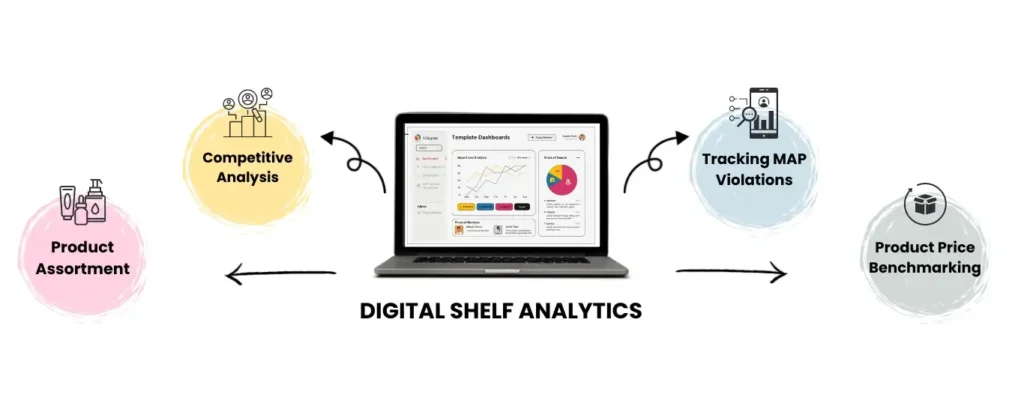
Digital shelf analytics tools give you the hard facts you need:
- Your Actual Organic Share of Voice Numbers: Tracking your precise organic share of voice for your most important keywords, categories, and against specific competitors.
- Broader Visibility Trends: Share of Search Analytics: Seeing not just your visibility, but how the whole category is shifting. What are people searching for overall?
- Where You Rank: Amazon Keyword Ranking: Knowing exactly where your products land for your critical search terms – page one? Page three? Buried?
- How You Stack Up: Competitor Benchmarking: Comparing your oSOV, pricing, content quality, review scores, and availability directly against your key rivals. Where are they beating you? Where are you winning?
- Pricing Wars: Monitoring your prices and promotions versus competitors in real-time across different retailers. Are you priced out?
Without digital shelf analytics, you’re guessing. You might feel like your organic share of voice is low, but you won’t know the exact numbers, the specific keywords where you’re weak, or how your tactics truly measure up. This data is the fuel for smart, effective action.
Taking Action: How to Actually Boost Your Organic Share of Voice
Knowing is half the battle. The other half is doing. Here’s a practical roadmap to start strengthening your organic share of voice:
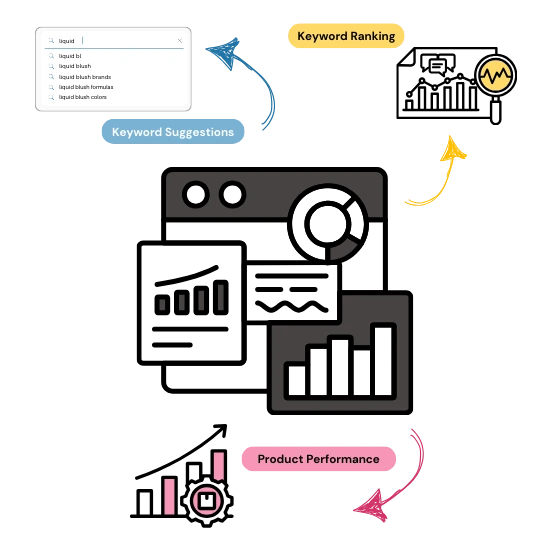
- Dig Deep on Marketplace Keywords: Go beyond basic tools. Leverage the search term reports available in your marketplace seller/brand portal (like Amazon Brand Analytics). Use specialized third-party tools like 42Signals. Spy on competitor listings – what terms are they using? Find those high-volume, relevant keywords where you might realistically compete. This research is the absolute bedrock of improving your share of search visibility.
- Optimize Your Listings Like Your Business Depends On It (It Might): Use your keyword insights to craft powerful, clear titles that include your main keywords. Write benefit-driven bullet points that incorporate secondary keywords naturally. Build a detailed description that answers customer questions and tells your product’s story. Crucially, make every word original – plagiarism detectors are sharp, and duplicate content hurts.
- Use the Right Images: Grainy resolutions won’t make it. Get a photographer who can click high-quality, professional images and videos that are great for engagement. Visuals in the right light and placement convert shoppers into buyers.
- Make Reviews Your Top Priority: Implement simple, ethical systems to request reviews (like using the marketplace’s post-purchase email feature). Respond to every negative review professionally and promptly – show you care and fix issues. High ratings and review volume are non-negotiable for maintaining a strong organic share of voice. Ignore reviews at your peril.
- Stay Sharp on Price & Stock: Regularly check competitor pricing – don’t get undercut unknowingly. Run targeted promotions to boost visibility and sales velocity. Most importantly, NEVER let your best-sellers go out of stock. Use forecasting tools religiously. Stockouts kill your momentum and your ranking.
The Never-Ending Job: Watch, Learn, Tweak, Repeat
Marketplaces tweak their algorithms constantly. Competitors launch new products or slash prices. Shopper search habits evolve. New trends emerge. That’s why continuous monitoring via digital shelf analytics and share of search analytics is non-negotiable. You need to:
- Watch: Keep a regular eye on your core organic share of voice metrics, keyword rankings, and what competitors are doing. Daily or weekly checks are ideal.
- Learn: When you see a change – good or bad – dig into the why. Did your ranking drop because a competitor ran a promotion? Is a new keyword gaining traction? Did your reviews dip? Use competitor benchmarking to understand market shifts.
- Tweak: Based on what you learn, take action. Update your listing content. Adjust your pricing strategy. Run a flash sale. Improve your images. Refine your keyword targets. Test different approaches.
- Repeat: Measure the impact of your changes. Did your oSOV improve? Did sales increase? Then start the cycle again.
Wrapping it Up: Focus on What Matters
The digital shopping world has changed. While traditional SEO still plays a role for brand discovery, the crucial battleground for product discovery and instant purchase is dominated by online marketplaces. Your organic share of voice (oSOV) on these platforms – your natural visibility when shoppers search – is now as vital as that coveted #1 spot on Google used to be. It’s your direct connection to buyers who are ready to purchase right now.
Choosing to ignore your marketplace organic share of voice is essentially handing over sales and visibility to competitors who get it.
The first step? Start measuring your organic share of voice today. Invest in a tool like 42Signals (free trial here) to get an understanding of where you stand in the marketplace.
Frequently Asked Questions
How do you define share of voice?
Share of Voice (SOV) is a metric that shows how much visibility or presence a brand has in comparison to its competitors within a specific channel or market. It reflects the percentage of total advertising, media coverage, or online mentions that your brand captures in your industry.
In simple terms, it answers the question: “How loud is your brand compared to others?”
SOV can be measured across different areas, such as:
Organic search traffic
Paid advertising (e.g., search ads)
Social media engagement
Press mentions
How do you calculate SOV?
The formula to calculate Share of Voice typically looks like this:
SOV (%) = (Your Brand’s Media Spend or Impressions / Total Market Media Spend or Impressions) × 100
For example:
If your brand spent $10,000 on online ads, and the total market spend (including competitors) was $100,000, your SOV would be:
(10,000 / 100,000) × 100 = 10% SOV
In digital marketing, you can also calculate SOV using:
Click share in PPC campaigns
Number of mentions across social media
Share of keyword rankings in SEO
What is the meaning of share of voice?
Share of Voice refers to how much attention your brand is getting in the market compared to competitors. It’s a way to measure your visibility and influence across various platforms, including advertising, PR, social media, and search engines.
A higher SOV usually means your brand is more dominant or recognizable within the market, which often correlates with increased brand awareness and customer trust.
What is SOV and SOM?
SOV (Share of Voice) and SOM (Share of Market) are two different but related metrics:
- SOV tells you how much presence or visibility your brand has in terms of marketing efforts, like advertising, media mentions, or keyword rankings.
- SOM (Share of Market) measures your actual sales performance—the percentage of total industry sales your company secures.
SOV shows brand exposure. SOM shows sales performance.
If your SOV is consistently higher than your SOM, it may suggest you’re underperforming in sales relative to your visibility—or that your campaigns are building future sales potential.

